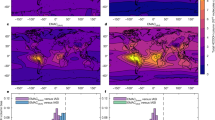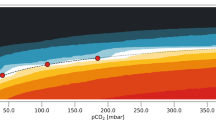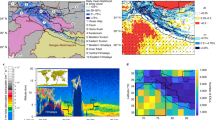Abstract
The oxidative capacity1 of the atmosphere determines the lifetime and ultimate fate of atmospheric trace species. It is controlled by the presence of highly reactive radicals, particularly OH· formed as a result of ozone photolysis. The dramatic depletion of ozone in Arctic surface air during polar sunrise2,3 therefore offers an opportunity to improve our understanding of the processes controlling ozone abundance and hence the oxidative capacity of the atmosphere. Ozone destruction is catalysed by bromine atoms4 and is terminated once bromine reacts with formaldehyde to form relatively inert hydrogen bromide, but neither the activation of bromine nor the contribution of formaldehyde are fully understood. Particularly troubling is the failure of current models5,6,7 to simulate the high formaldehyde concentrations7,8,9 in Arctic surface air. Here we report measurements in Arctic snow and near-surface air, which suggest that photochemical production at the air–snow interface accounts for the discrepancy between observed and predicted formaldehyde concentrations. The strength of this source is comparable to that of the dominant formaldehyde source in the free troposphere (the reaction between OH· and methane) and implies that formaldehyde photolysis canbe a dominant source of oxidizing free radicals in the lower polar troposphere. We expect that formaldehyde will also affect photochemistry at the snow surface to facilitate the release of bromine into the lower troposphere—the initial step in Arctic tropospheric ozone depletion.
This is a preview of subscription content, access via your institution
Access options
Subscribe to this journal
Receive 51 print issues and online access
$199.00 per year
only $3.90 per issue
Buy this article
- Purchase on Springer Link
- Instant access to full article PDF
Prices may be subject to local taxes which are calculated during checkout



Similar content being viewed by others
References
Thompson, A. M. The oxidizing capacity of the Earth's atmosphere: probable past and future changes. Science 256, 1157–1165 (1992).
Bottenheim, J. W., Gallant, A. J. & Brice, K. A. Measurements of NOyspecies and O3at 82° N latitude. Geophys. Res. Lett. 13, 113–116 (1986).
Oltmans, S. J. & Komhyr, W. D. Surface ozone distributions and variations from 1973–1984 measurements at the NOAA Geophysical Monitoring for Climate Change Baseline observatories. J. Geophys. Res. D 91, 5229–5236 (1986).
Barrie, L. A., Bottenheim, J. W., Schnell, R. C., Crutzen, P. J. & Rasmussen, R. A. Ozone destruction and photochemical reactions at polar sunrise in the lower Arctic atmosphere. Nature 334, 138–141 (1988).
Sander, R., Vogt, R., Harris, G. W. & Crutzen, P. J. Modeling the chemistry of ozone, halogen compounds, and hydrocarbons in the arctic troposphere during spring. Tellus B 49, 522–532 (1997).
Neftel, A., Bales, R. C. & Jacob, D. J. in Ice Core Studies of Global Biochemical Cycles (ed. Delmas, R.) (NATO ASI Ser. I, Springer, New York, (1995).
Shepson, P. B. et al. Sources and sinks of carbonyl compounds in the Arctic Ocean boundary layer: polar ice floe experiment. J. Geophys. Res. 101, 21081–21089 (1996).
De Serves, C. Gas phase formaldehyde and peroxide measurements in the Arctic atmosphere. J. Geophys. Res. 99, 25391–25398 (1994).
Fuhrer, K., Hutterli, M. & McConnell, J. R. in Chemical Exchange between the Atmosphere and Polar Snow (eds Wolff, E. & Bales, R.) (NATO ASI Ser. I, Springer, New York, (1996).
Fan, Q. & Dasgupta, P. K. Continuous automated determination of atmospheric formaldehyde at the parts per trillion level. Anal. Chem. 66, 551–556 (1994).
Hopper, J. F. & Hart, W. R. Meterological aspects of the 1992 Polar Sunrise Experiment. J. Geophys. Res. 99, 25315–25328 (1994).
McConnell, J. C. et al. Photochemical bromine production implicated in Arctic boundary layer ozone depletion. Nature 355, 150–152 (1992).
Honrath, R. E. & Jaffe, D. A. The seasonal cycle of nitrogen oxides in the Arctic troposphere at Barrow, Alaska. J. Geophys. Res. 97, 20615–20630 (1992).
Beine, H. J. et al. NOxduring ozone depletion events in the Arctic troposphere at Ny-ålesund, Svalbard. Tellus B 49, 556–565 (1997).
Staffelbach, T., Neftel, A., Stauffer, B. & Jacob, D. Arecord of the atmospheric methane sink for formaldehyde in polar ice cores. Nature 349, 603–605 (1991).
Dong, S. & Dasgupta, P. K. Solubility of gaseous formaldehyde in liquid water and generation of trace standard formaldehyde. Environ. Sci. Technol. 20, 637–640 (1986).
Conklin, M. H. & Bales, R. C. SO2uptake on ice spheres: Liquid nature of the ice-air interface. J. Geophys. Res. 98, 16851–16855 (1993).
Prinn, R. G. et al. Atmospheric trends and lifetime of CH3CCl3and global OH concentrations. Science 269, 187–192 (1995).
Vaghjiani, G. L. & Ravishankara, A. R. New measurement of the rate coefficient for the reaction of OH with methane. Nature 350, 406–409 (1991).
Muller, T., Bleiss, W., Martin, C. D., Rogaschewski, S. & Fuhr, G. Snow algae from northwest Svalbard: Their identification, distribution, pigment and nutrient content. Polar Biol. 20, 14–32 (1998).
Stewart, W. D. P. (ed.) Algal Physiology and Biochemistry (Univ. California Press, Berkeley, (1974).
Qian, J.-G., Mopper, K. & Kieber, D. J. Photochemical production of the OH radical and formaldehyde in Antarctic waters. Antarctic J. R. 30, 141–143 (1995).
Impey, G. A., Shepson, P. B., Hastie, D. R. & Barrie, L. A. Measurements of photolyzable chlorine and bromine during the Polar Sunrise Experiment 1995. J. Geophys. Res. 102, 16005–16010 (1997).
Impey, G. A. et al. Measurements of photolyzable halogen comounds and bromine radicals during the Polar Sunrise Experiment 1997. J. Atmos. Chem.(in the press).
Oum, K. W., Lakin, M. J., DeHaan, D. O., Brauers, T. & Finlayson-Pitts, B. J. Formation of molecular chlorine from the photolysis of ozone and aqueous sea-salt particles. Science 279, 74–77 (1998).
Oum, K. W., Lakin, M. Y. & Finlayson-Pitts, B. J. Bromine activation in the troposphere by the dark reaction of O3with seawater ice. Geophys. Res. Lett. 25, 3923003926 (1998).
Mopper, K. & Zhou, X. Hydroxyl radical photoproduction in the sea and its potential impact on marine processes. Science 250, 661–664 (1990).
Vaughan, P. P. & Blough, N. V. Photochemical formation of hydroxyl radical by constituents of natural waters. Envrion. Sci. Technol. 32, 2947–2953 (1998).
Li, S.-M. & Winchester, J. W. Water soluble organic constituents in Arctic aerosols and snow pack. Geophys. Res. Lett. 20, 45–48 (1993).
Mozurkewich, M. Mechanism for the release of halogens from sea-salt particles by free radical reactions. J. Geophys. Res. 100, 14199–142107 (1995).
Haan, D. & Raynaud, D. Ice core record of CO variations during the last two milennia: atmospheric implications and chemical interactions within the Greenland ice. Tellus B 50, 253–262 (1998).
Acknowledgements
We thank J. Bottenheim, L. Barrie and P. Dasgupta for discussions; K. Anlauf for use of the Alert ozone data; and J. Deary, A. Gallant, Atmospheric Environment Service, the Canadian Forces, and the Department of National Defense, Canada, for technical and logistic support. This work was supported by the NSF.
Author information
Authors and Affiliations
Corresponding author
Rights and permissions
About this article
Cite this article
Sumner, A., Shepson, P. Snowpack production of formaldehyde and its effect on the Arctic troposphere. Nature 398, 230–233 (1999). https://doi.org/10.1038/18423
Received:
Accepted:
Issue Date:
DOI: https://doi.org/10.1038/18423
This article is cited by
-
Dissolved organic carbon in summer precipitation and its wet deposition flux in the Mt. Yulong region, southeastern Tibetan Plateau
Journal of Atmospheric Chemistry (2019)
-
Photochemical production of molecular bromine in Arctic surface snowpacks
Nature Geoscience (2013)
-
DOAS observations of formaldehyde and its impact on the HOx balance in the tropical Atlantic marine boundary layer
Journal of Atmospheric Chemistry (2010)
-
Modelling the multiphase near-surface chemistry related to ozone depletions in polar spring
Journal of Atmospheric Chemistry (2009)
-
An ozone depletion event in the sub-arctic surface layer over Hudson Bay, Canada
Journal of Atmospheric Chemistry (2007)
Comments
By submitting a comment you agree to abide by our Terms and Community Guidelines. If you find something abusive or that does not comply with our terms or guidelines please flag it as inappropriate.



